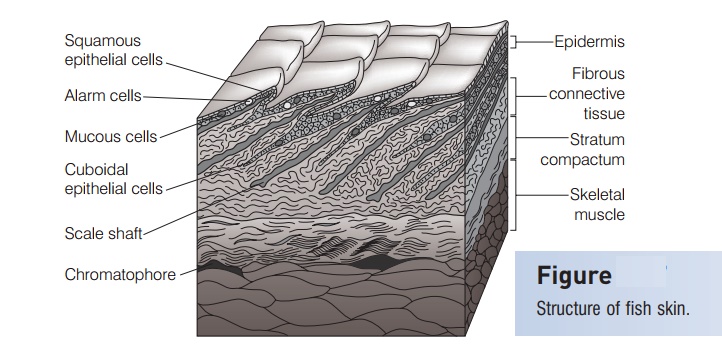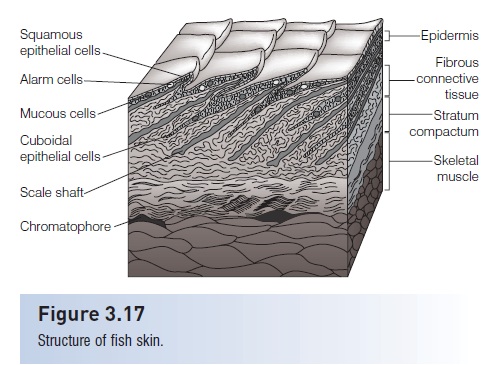Chapter: The Diversity of Fishes: Biology, Evolution, and Ecology: Skeleton, skin, and scales
Epidermis - Integumentary skeleton of Fishes

Integumentary skeleton
The integument is composed of the skin and skin derivatives,and includes scales in fishes and feathers and hair in birds and mammals. The integument forms an external protective structure parallel to the internal endoskeleton and serves as the boundary between the fish and the external environment. The structure of the skin in fishes is similar to that of other vertebrates, with two main layers:an outer epidermis and an inner dermis. See Elliott (2000)for a review of the integumentary system.
Epidermis
The epidermis is ectodermal in origin. In lampreys and higher vertebrates, the epidermis is stratified. The lowest layer is the stratum germinativum, composed of columnar cells (Fig. 3.17). It is the generating layer that gives rise to new cells. In hagfishes, lampreys, and bony fishes, thereis an outer thin film of non cellular dead cuticle (Whitear1970). The outer part of the epidermis in terrestrial vertebrates is the stratum corneum, which is composed of dead, horny, keratinized squamous cells that form hair and feathers. Breeding tubercles in fishes may also containkeratin (Wiley & Collette 1970).

Figure 3.17
Structure of fish skin.
The inner dermis contains blood vessels, nerves, sense organs, and connective tissue. It is derived from embryonic mesenchyme of mesodermal origin. It is composed of fibro elastic and nonelastic collagenous connective tissue with relatively few cells. Dermal layers include an upper,relatively thin layer of loose cells, the stratum laxum(or stratum spongiosum) and a lower, compact thick layer, the stratum compactum (Fig. 3.17). In adult fishes, the dermis is much thicker than the epidermis. The thickness of the integument depends on the thickness of the dermis.Scaleless species, such as catfishes of the genus Ictalurus,have relatively thick, leathery skin. The Ocean Sunfish (Mola) has the skin reinforced by a hard cartilage layer,50–75 mm thick. Snail fishes (Liparis, Liparidae) have a transparent jellylike substance up to 25 mm thick in their dermis.
The chemical composition of fish skin is poorly studied,but some generalizations can be made. There is less water in fish skin than in fish muscle, a higher ash content, and similar amounts of protein. The main protein in skin is collagen, which is why fish skin has been used to manufacture glue. The chief minerals in fish skin are phosphorus,potassium, and calcium (Van Oosten 1957). The ash compositionof the skin of the Coho Salmon (Oncorhynchuskisutch) is:
P2O5 33% CaO 14%
Cl 21% Na2O 9%
K2O 17% MgO 2%
Among the functions of the skin are mechanical protection and production of mucus by epidermal mucous cells. Mucin is a glycoprotein, made up largely of albumin.Threads of mucin hold a large amount of water. It is possibleto wring the water out of mucus, leaving threads ofmucin. Among the first multicellular glands to evolve were the mucous glands of hagfishes (Myxinidae), called threadcells (Fernholm 1981). The oft-told story is that a hagfish+a bucket of water =a bucket of slime.
Other structures in the skin of fishes include epidermal venom glands associated with spines on fins (weeverfishes, Trachinidae; mad tom catfishes, Noturus), opercles (venomous toadfishes, Thalassophryninae), and the tail (stingrays, Dasyatidae). Photophores, which produce bioluminescence, develop from the germinative layer of the epidermis. Color is due to chromatophores, which are modified dermal cells containing pigment. The skin also contains important receptors of physical and chemical stimuli.
Related Topics